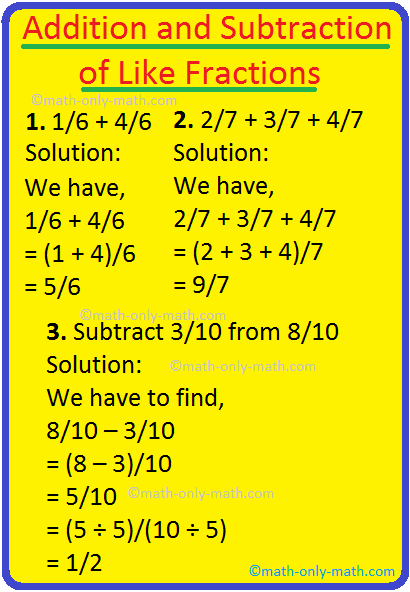Subscribe to our ▶️ YouTube channel 🔴 for the latest videos, updates, and tips.
Addition and Subtraction of Like Fractions
Here we will learn about addition and subtraction of like fractions.
Addition of Like Fractions:
In order to add two or more like fractions, we may follow the following steps:
Step I:
Obtain the fractions.
Step II:
Add the numerators of all fractions.
Step III:
Retain the common denominator of all fractions.
Step IV:
Write the fraction as Result in Step II / Result in Step III.
For Example:
Add the following fractions.
1. 1/6 + 4/6
Solution:
We have,
1/6 + 4/6
= (1+4)/6
= 5/6
2. 2/7 + 3/7 + 4/7
Solution:
We have,
2/7 + 3/7 + 4/7
= (2+3+4)/7
= 9/7
3. 23/5 + 4/5 + 12/5
Solution:
We have,
23/5 + 4/5 + 12/5
= (2 × 5 + 3)/5 + 4/5 + (1 × 5 + 2)/5
= (10 + 3)/5 + 4/5 + (5 + 2)/5
= 13/5 + 4/5 + 7/5
= (13 + 4 + 7)/5
= 24/5
4. 11/4 + 23/4 + 71/4
Solution:
We have,
11/4 + 23/4 + 71/4
= (1 × 4 + 1)/4 + (2 × 4 + 3)/4 + (7 × 4 + 1)/4
= (4 + 1)/4 + (8 + 3)/4 + (28 + 1)/4
= 5/4 + 11/4 + 29/4
= (5 + 11 + 29)/4
= 45/4
Subtraction of Like Fractions:
To subtract two or more like fractions we simply subtract their numerators and keep the same denominator.
In order to subtract two like fractions, we may follow the following steps:
Step I:
Obtain the two fractions and their numerators.
Step II:
Subtract the smaller numerator from the bigger numerator.
Step III:
Retain the common denominator.
Step IV:
Write the fraction as Result in Step II / Result in Step III.
For Example:
1. Subtract 3/10 from 8/10
Solution:
We have to find,
8/10 – 3/10
= (8 – 3)/10
= 5/10
= (5 ÷ 5)/(10 ÷ 5) [Dividing the numerator and denominator by their HCF (highest common factor) 5].
= 1/2
2. Compute: 5/12 – 7/12 + 11/12
Solution:
We have,
5/12 – 7/12 + 11/12
= (5-7+11)/12
= (11-2)/12
= 9/12
= (9 ÷ 3)/(12 ÷ 3) [Dividing the numerator and denominator by their HCF (highest common factor) 3].
= 3/4
3. Simplify: 42/3 + 1/3 – 41/3
Solution:
We have,
42/3 + 1/3 – 41/3
= (4 × 3 + 2)/3 + 1/3 - (4 × 3 + 1)/3
= (12+2)/3 + 1/3 – (12+1)/3
= 14/3 + 1/3 - 13/3
= (14 + 1 – 13)/3
= (15 – 13)/3
= 2/3
4. Subtract \(\frac{3}{7}\) from \(\frac{5}{7}\).
Solution:
\(\frac{5}{7}\) - \(\frac{3}{7}\)
= \(\frac{5 - 3}{7}\)
= \(\frac{2}{7}\)
5. Emily has \(\frac{7}{12}\) hrs to reach her school. She takes \(\frac{5}{12}\) hrs to finish her breakfast. How much time is left with Emily to reach her school?
Solution:
We subtract \(\frac{5}{12}\) from \(\frac{7}{12}\).
\(\frac{7}{12}\) - \(\frac{5}{12}\)
= \(\frac{7 - 5}{12}\)
= \(\frac{2}{12}\) hrs is left with her.
For Example:
Add the following fractions.
1. 1/6 + 4/6Solution:
We have,
1/6 + 4/6
= (1+4)/6
= 5/6
2. 2/7 + 3/7 + 4/7
Solution:
We have,
2/7 + 3/7 + 4/7
= (2+3+4)/7
= 9/7
3. 23/5 + 4/5 + 12/5
Solution:
We have,
23/5 + 4/5 + 12/5
= (2 × 5 + 3)/5 + 4/5 + (1 × 5 + 2)/5
= (10 + 3)/5 + 4/5 + (5 + 2)/5
= 13/5 + 4/5 + 7/5
= (13 + 4 + 7)/5
= 24/5
4. 11/4 + 23/4 + 71/4
Solution:
We have,
11/4 + 23/4 + 71/4
= (1 × 4 + 1)/4 + (2 × 4 + 3)/4 + (7 × 4 + 1)/4
= (4 + 1)/4 + (8 + 3)/4 + (28 + 1)/4
= 5/4 + 11/4 + 29/4
= (5 + 11 + 29)/4
= 45/4
● Fraction
Representations of Fractions on a Number Line
Conversion of Mixed Fractions into Improper Fractions
Conversion of Improper Fractions into Mixed Fractions
Interesting Fact about Equivalent Fractions
Addition and Subtraction of Like Fractions
Addition and Subtraction of Unlike Fractions
Inserting a Fraction between Two Given Fractions
Numbers Page
6th Grade Page
From Addition and Subtraction of Like Fractions to HOME PAGE
Didn't find what you were looking for? Or want to know more information about Math Only Math. Use this Google Search to find what you need.



New! Comments
Have your say about what you just read! Leave me a comment in the box below. Ask a Question or Answer a Question.